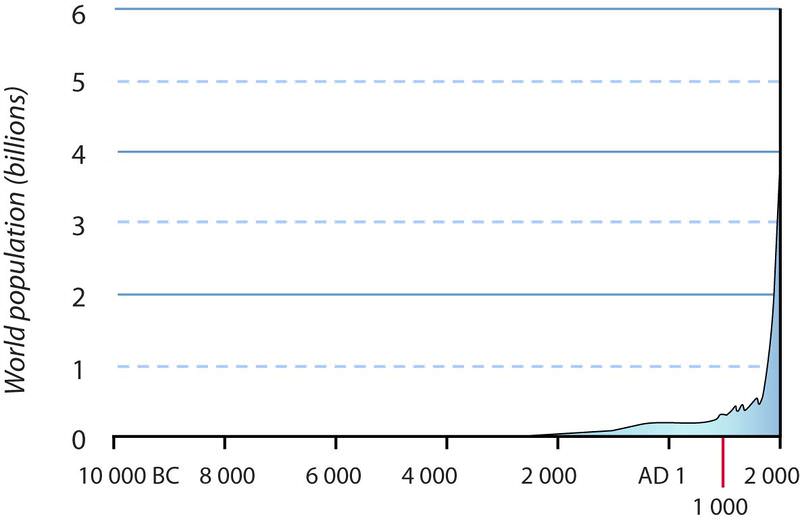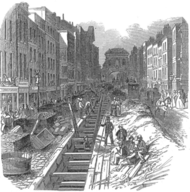17.10人口增长的革命
章节大纲
-
Where on the graph are the major population changes?
::图表上的主要人口变化在哪里?Let's look at this graph again. It shows human population from 10,000 BC through 2000 AD. Where are the big changes in slope of the line? Can you identify them? In this concept, we'll learn what causes them.
::让我们再看看这个图。 它显示了从公元前10,000公元前到2000年的人类人口。 线的斜坡变化在哪里? 你能识别它们吗? 在这个概念中, 我们会知道它们的原因。What Causes Human Populations to Grow?
::是什么原因导致人口增长?Look at the graph above. Human population increased dramatically at certain times. The graph begins 10,000 BC, although you can't really see the line. Population starts to rise perceptibly at around 1800 BC. The numbers begin to rise dramatically about 200 years ago. What causes these changes?
::看看上面的图表。 人口在一定时间急剧增长。 图表始于公元前10,000公元前, 尽管您无法真正看到这一线。 人口开始在公元前1800年左右明显增长。 数字在200年前开始大幅增长。 是什么原因导致这些变化的?Agricultural Revolution
::农业革命 农业革命Farming was developed about 10,000 years ago. Farming meant a steady supply of food. People could settle in villages. The rise at around 1800 BC is due to increased farming and the rise of cities and towns. The population rises steadily until around 1800 AD. At that time it shoots up dramatically. Really dramatically. What happened?
::农业是在大约一万年前发展起来的。农业意味着稳定的粮食供应。人们可以定居在村庄。公元前1800年左右的上升是由于农耕增加以及城镇和城镇的上升。人口一直稳定增长到公元前1800年左右。当时,人口急剧上升。非常戏剧化。到底发生了什么?Industrial Revolution
::工业革命The Industrial Revolution is what happened. The Industrial Revolution began in the late 1700s in Europe, North America, and a few other places. Before the Industrial Revolution, most labor was done by people. The Industrial Revolution changed the source of power from humans to fossil fuels . This allowed more work to be done and more food to be grown. People began to move into cities.
::工业革命就是这样发生的。工业革命始于1700年代末期的欧洲、北美和其他一些地方。在工业革命之前,大部分劳动都是由人完成的。工业革命将权力来源从人类转变为化石燃料。这使得可以做更多的工作,种植更多的粮食。人们开始搬进城市。Where the Industrial Revolution was taking place, the human population started to grow really fast. The birth rate was always high. What changed was the death rate. The population grew because more people stayed alive. The death rate fell for several reasons:
::在工业革命发生的地方,人口开始快速增长。出生率总是很高。变化的是死亡率。人口增长是因为有更多的人活着。死亡率由于几个原因下降:- New farm machines were invented. They increased the amount of food that could be produced. With more food, people were healthier and could live longer.
::新的农业机器被发明出来,它们增加了可以生产的粮食数量。 有了更多的粮食,人们就会更加健康,并且可以活得更长。
- Steam engines and railroads were built. These machines could quickly carry food long distances. This made food shortages less likely.
::建造了蒸汽发动机和铁路,这些机器可以迅速运送长途食物,从而降低了粮食短缺的可能性。
- Sanitation was improved. Sewers were dug to carry away human wastes ( Figure ). This helped reduce the spread of disease.
::改善了环境卫生,挖掘了污水,以清除人类废物(图)。 这有助于减少疾病的传播。
Digging a London sewer (1840s). Before 1800, human wastes were thrown into the streets of cities such as London. In the early 1800s, sewers were dug to carry away the wastes.
::挖掘伦敦下水道(1840年代)。1800年以前,废物被扔到伦敦等城市的街道上,在1800年代初,挖掘下水道将废物运走。With better food and less chance of disease, the death rate fell. More children lived long enough to reach adulthood and have children of their own. As the death rate fell, the birth rate stayed high for awhile. This caused rapid population growth.
::随着食物的改善和疾病机会的减少,死亡率下降,更多的儿童活到成年并拥有自己的孩子,随着死亡率的下降,出生率保持了一段时间的高水平,这导致了人口的快速增长。The Green Revolution
::绿色革命The most recent increase in the slope of the population line is because of another advance in agriculture. The Green Revolution began in the mid-1900s. The Green Revolution has allowed billions of people to be added to the population in the past few decades. New methods and products increased how much food could be grown. These advances include:
::人口线坡度最近的增长是由于农业的又一进步。绿色革命始于19世纪中叶。绿色革命使得数十亿人在过去几十年中增加了人口。新的方法和产品增加了多少粮食可以种植。这些进步包括:- Improving crops by selecting for certain genetic traits. The desired traits promote productivity. Recently, genetically engineered crops have been introduced.
::通过选择某些遗传特征改善作物,期望的特征能提高生产力,最近引进了转基因作物。
- Increasing the use of artificial fertilizers and chemical pesticides .
::增加人工肥料和化学杀虫剂的使用。
- Increasing the use of agricultural machinery: plowing, tilling, fertilizing, picking, and transporting. These machines are powered by fossil fuels, rather than humans.
::农业机械的使用增加:耕种、耕种、施肥、采摘和运输。 这些机器是由化石燃料而不是由人类驱动的。
- Increasing access to water . Many rivers have been dammed. Wells tap into many aquifers .
::许多河流被淹没,水井钻进许多蓄水层。
The Green Revolution has increased the productivity of farms immensely. A century ago, a single farmer produced enough food for 2.5 people, but now a farmer can feed more than 130 people. The Green Revolution is credited for feeding 1 billion people that would not otherwise have been able to live.
::绿色革命极大地提高了农场的生产率。 一个世纪前,一个农民生产了2.5人所需的足够粮食,但现在一个农民可以养活130多人。 绿色革命可以用来养活10亿本来无法生存的人。The Health Revolution
::健康革命Health care has been improving over the most recent centuries. Vaccines were developed that could prevent many diseases ( Figure ). Antibiotics were discovered that could cure most infections caused by bacteria. Together, these two advances saved countless lives.
::近几个世纪以来,卫生保健一直在改善,研制了可以预防许多疾病的疫苗(图 ) , 发现抗生素可以治愈细菌造成的大部分感染。 这两项进步共同拯救了无数生命。This child is getting a polio vaccine. She will never get sick with polio, which could save her life or keep her from becoming crippled.
::这个孩子正在接种脊髓灰质炎疫苗,她永远不会患上脊髓灰质炎,这可以挽救她的生命或防止她残废。Summary
::摘要- Farming allowed people to have a steady food source and settle down. The Green Revolution has dramatically increased agricultural productivity.
::农业使人们拥有稳定的食物来源并安顿下来。 绿色革命极大地提高了农业生产率。
- The Industrial Revolution brought new machinery, increased the food supply, and improved sanitation.
::工业革命带来了新的机械,增加了粮食供应,改善了卫生条件。
- Vaccinations and antibiotics have greatly improved human health.
::接种疫苗和抗生素大大改善了人类健康。
- With a dramatically lower death rate, human populations have grown.
::随着死亡率急剧下降,人口有所增加。
Review
::回顾- What caused the first rise in human population?
::是什么导致人口首次增加?
- Why has the Industrial Revolution altered human population numbers?
::为什么工业革命改变了人口数量?
- How has the Green Revolution increased agricultural productivity?
::绿色革命是如何提高农业生产力的?
- If the birth rate doesn't change but the death rate goes down, what happens to population?
::如果出生率没有改变,但死亡率下降,人口会怎样?
Explore More
::探索更多Use the resources below to answer the questions that follow.
::利用以下资源回答以下问题。- Where did most people work in the late 1700s? Who did they work for?
::大多数人在1700年代后期在哪里工作?
- What did the new machines do?
::新机器是做什么的?
- What became more affordable?
::还有什么更能负担得起呢?
- Why did families move? Where did they move from and to?
::为什么家庭搬家?他们从哪儿搬来搬去的?
- Who were the workers? Who did they work for?
::工人是谁 他们为谁工作
- What problems did industrialization cause?
::工业化造成哪些问题?
- Where were the worst conditions?
::最坏的条件在哪里?
- Why were unions formed?
::为什么组成工会?
- New farm machines were invented. They increased the amount of food that could be produced. With more food, people were healthier and could live longer.


